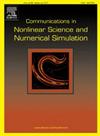Multiscale grayscale dispersion entropy: A new nonlinear dynamics metric for time series analysis
IF 3.4
2区 数学
Q1 MATHEMATICS, APPLIED
Communications in Nonlinear Science and Numerical Simulation
Pub Date : 2025-01-07
DOI:10.1016/j.cnsns.2025.108597
引用次数: 0
Abstract
Link dispersion entropy (LDE), as an improvement of dispersion entropy (DE), focuses on transition states between adjacent dispersion patterns. However, the transition states of dispersion patterns at different intervals are ignored and parameters of LDE have a significant impact on entropy value. To address these problems, grayscale dispersion entropy (GDE) is proposed, which introduces transition step size considering the transition states between dispersion patterns at different intervals, reflecting the state transition information comprehensively and uses a grayscale matrix instead of a transition probability matrix to weaken the effect of parameter on entropy value. Moreover, multiscale grayscale dispersion entropy (MGDE) is proposed as a multiscale version of GDE, which reflects the complexity at various time scales. Simulation experiments have confirmed that GDE possesses the capability to precisely detect dynamic changes in signal and accurately represent signal complexity. For two types of publicly available ship radiated noise datasets and rolling bearing dataset, MGDE has better classification performance than other four complexity metrics.多尺度灰度色散熵:一种新的用于时间序列分析的非线性动力学度量
链接色散熵(LDE)是对色散熵(DE)的改进,主要关注相邻色散模式之间的过渡状态。然而,不同间隔的色散模式的过渡状态被忽视,而且 LDE 的参数对熵值有很大影响。针对这些问题,提出了灰度色散熵(GDE),它引入了考虑不同间隔色散模式之间过渡状态的过渡步长,全面反映了状态过渡信息,并使用灰度矩阵代替过渡概率矩阵,削弱了参数对熵值的影响。此外,还提出了多尺度灰度色散熵(MGDE),作为 GDE 的多尺度版本,它反映了不同时间尺度上的复杂性。模拟实验证实,GDE 具有精确检测信号动态变化的能力,并能准确表示信号的复杂性。对于两种公开的船舶辐射噪声数据集和滚动轴承数据集,MGDE 比其他四种复杂度指标具有更好的分类性能。
本文章由计算机程序翻译,如有差异,请以英文原文为准。
求助全文
约1分钟内获得全文
求助全文
来源期刊

Communications in Nonlinear Science and Numerical Simulation
MATHEMATICS, APPLIED-MATHEMATICS, INTERDISCIPLINARY APPLICATIONS
CiteScore
6.80
自引率
7.70%
发文量
378
审稿时长
78 days
期刊介绍:
The journal publishes original research findings on experimental observation, mathematical modeling, theoretical analysis and numerical simulation, for more accurate description, better prediction or novel application, of nonlinear phenomena in science and engineering. It offers a venue for researchers to make rapid exchange of ideas and techniques in nonlinear science and complexity.
The submission of manuscripts with cross-disciplinary approaches in nonlinear science and complexity is particularly encouraged.
Topics of interest:
Nonlinear differential or delay equations, Lie group analysis and asymptotic methods, Discontinuous systems, Fractals, Fractional calculus and dynamics, Nonlinear effects in quantum mechanics, Nonlinear stochastic processes, Experimental nonlinear science, Time-series and signal analysis, Computational methods and simulations in nonlinear science and engineering, Control of dynamical systems, Synchronization, Lyapunov analysis, High-dimensional chaos and turbulence, Chaos in Hamiltonian systems, Integrable systems and solitons, Collective behavior in many-body systems, Biological physics and networks, Nonlinear mechanical systems, Complex systems and complexity.
No length limitation for contributions is set, but only concisely written manuscripts are published. Brief papers are published on the basis of Rapid Communications. Discussions of previously published papers are welcome.
 求助内容:
求助内容: 应助结果提醒方式:
应助结果提醒方式:


